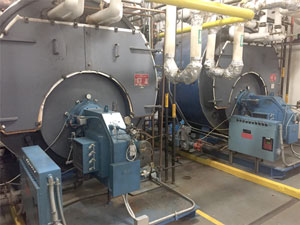Boilouts / Boiler Waterside Cleanings
Steam boilers often accumulate debris over the course of the operating season which is not removed by the normal blowdown of the boiler. As the boiler operates, suspended solids accumulate in the same manner as dissolved solids. This debris can combine with the minerals contained in the makeup water and dissolved particles found in the condensate.
If given a chance, this debris as well as some precipitated minerals will coat the heat exchange surfaces in the boiler. The deposits have an insulating effect and retard heat transfer. The deposits can also create any number of operating problems including general corrosion, differential heating, and electrolytic corrosion to name a few.
To combat this process, a boilout (or a waterside cleaning) is recommended to maintain peak operating efficiency and add to the longevity of the operating system. Facilities often clean the fireside to reduce the effects of deposits but fail to acknowledge the benefits of waterside cleanings.
Energy Loss Due to Scale Deposits*
|
|
Fuel |
Loss, % of Total Use |
|
|
Scale |
Scale Type |
||
|
Inches |
“Normal” |
High Iron |
Iron plus Silica |
|
1/64 |
1.0 |
1.63 |
3.5 |
|
1/32 |
2.0 |
3.1 |
7.0 |
|
3/64 |
3.0 |
4.7 |
— |
|
1/16 |
3.9 |
6.2 |
— |
Performing annual visual inspections of the boiler’s waterside will provide additional information about the operating conditions and future treatment and maintenance modifications and concerns.
Monitoring and recording the boiler’s flue stack temperature will give an indication if scale is present on the internal surfaces. As the flue stack temperature increases, under given operational loading, it may correspond to an increase in the amount of scale or deposits.
 Performing a boilout will aid in removing debris and some scale, if present. However, if severe scaling has occurred, a specialized cleaning may be required. Contact Purity Labs for additional information.
Performing a boilout will aid in removing debris and some scale, if present. However, if severe scaling has occurred, a specialized cleaning may be required. Contact Purity Labs for additional information.
* Source: U.S. Department of Energy. Office of Industrial Technologies. Energy Tips, Tip Sheet #7, Revised June 2001 and National Institute of Standards and Technology, Handbook 115, Supplement 1
